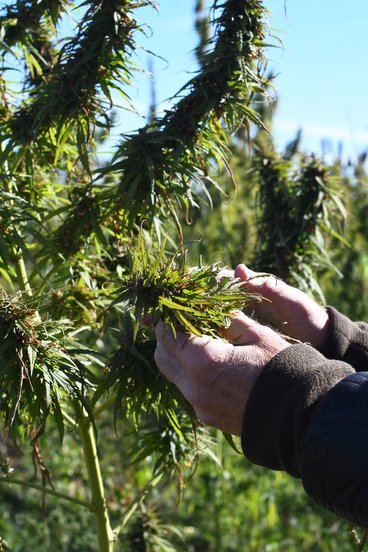Hemp is the plant we botanically know as Cannabis sativa, and so is marijuana. So what are university research teams doing cultivating this polarizing plant? Dr. Tom Michaels and his team are in their third season breeding hemp on campus with three different sites at the St. Paul Experiment Station dedicated to its evaluation and selection. Hemp has been cultivated in Minnesota for fiber and grain since settlement. However, burdensome regulations like the 1937 Marajuana Tax Act that were purportedly aimed at curbing recreational use of its intoxicating cousin limited commercial hemp production until commercial fields essentially disappeared. Meanwhile, hemp seed scattered during earlier eras of commercial production became naturalized and thrived in our Minnesota climate for over 80 years without cultivation, becoming adapted to Minnesota’s frigid winters and hot summers. Fast forward to 2018, the Farm Bill officially legalized cultivation of non-intoxicating industrial hemp plants with very low THC concentration for commercial purposes like grain and fiber, and opened the door for Dr. Michaels’ lab to initiate a breeding project to develop Minnesota-specific cultivars. Because of its climatic adaptation, naturalized hemp that Michaels' team collected throughout Minnesota became the source material for their cultivar development ambitions.

Hemp is a widely diverse plant that can be used to create fibers for clothing, insulation for building homes, cement alternatives, biofuels, food ingredients like oils and plant-based proteins, and even bioplastics. “Crops with multiple end uses help diversify income streams for farmers making plants with more than one end product more profitable to grow” said Dr. Michaels. During the breeding process, a variety of characteristics can be manipulated depending on the intended use of the plant. For instance, hemp plants used for grain and oil should have dense flower clusters bearing large seeds with light colored coats. Tall stalks with long internodes are favored for plants used to make fiber for textiles. In collaboration with Dr. George Weiblen’s lab at the University of Minnesota, Tom's project uses molecular markers to identify and select against plants with alleles that result in THC production and could otherwise result in crops that fail to meet the federal standards for industrial hemp.
Entry into these food and fiber markets has proven to be difficult however. “There isn’t the same level of infrastructure in the US for hemp grain and fiber production as there is for plants like cotton or soybean for example” explains Michaels. Dr. Michaels’ team is continuing to explore the added benefits of incorporating hemp into conventional crop rotations to encourage local farmers to try something new. Studies are currently being done to evaluate hemp’s ability to reduce the amount of nitrate discharged from fields. When nitrate is leached through the soil, it has the ability to enter nearby fresh water bodies and ground water where it becomes an environmental pollutant. Dr. Michaels’ team is currently working to determine whether hemp’s extensive root system has the ability to capture more nitrate than other traditional crops, making nitrate leaching less of an environmental risk and reducing the impact of the crop rotation.
The future of hemp is vast, diverse, and ever changing. Despite the political barriers that this plant has overcome, its sustainable qualities, hardy characteristics, and wide variety of uses is helping to rewrite its reputation.
